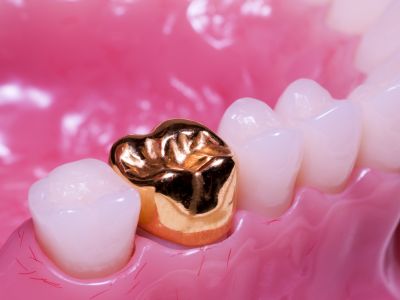Dental Restorations Part 2: Gold, Other Metals

When it comes to gold, there is no greater material that can replace tooth structure. Gold is the oldest and longest-lasting restorative material used in dentistry, and can be provided as a direct or indirect restoration. It is either mechanically retained, cemented, or a combination of both. A cemented restoration is different than a bonded restoration, which applies to many tooth-colored restorations discussed later. Suffice it to say, a bonded restoration is glued to a tooth, and that is the only force that keeps it in place.
Gold has many benefits. It is the most similar dental material to natural tooth structure. As a result, it doesn’t grind or wear down other teeth, it expands and contracts the same as natural teeth during temperature changes, and it requires the least removal of tooth structure to place — which means less risk for trauma to the tooth and a potential future root canal. Gold has no chemicals, and is the biologically compatible with humans and the environment. The softness of gold also allows it to be further pressed into a tooth, giving it the closest fit out of any restorative material, and a lower risk for microleakage over time. Gold as a metal is naturally antimicrobial, anti-plaque, and it does not corrode – which makes sense; it stays underwater in shipwrecks for hundreds of years and still looks immaculate when recovered!
Gold will not chip or fracture, nor does it discolor. It does not irritate gums, and it does not absorb oral fluids over time (as opposed to resin-based, tooth-colored composites, which absorb liquid and swell over the years). The only practical way these restorations fail is if they detach from the tooth and cant be recemented, the tooth fractures, gets a cavity, or the user wears through the material. As a result, gold is known to last decades or lifetimes.
Gold foil is the type of gold that can be provided as a direct restoration: done in the mouth, in one appointment. It is the oldest dental filling to ever remain in use. Gold foil goes back hundreds of years, and remained very common until around the 1950s when costs began rising and alternatives became more comfortable. It is a filling made from gold leaflets that are warmed until soft, tapped into the tooth, and polished to make a profoundly strong and long-lasting restoration. There is no bonding, no cementing – it is adapted into the tooth and retained with pure mechanics. A gold foil is potentially the longest lasting restoration ever made. Without complication, a gold foil will last a lifetime. As a result, there really is no known limit to how long these restorations can go. That’s a lot when considering the span of modern alternatives. Patients still seen with these restorations are often in their 80s or older. The fillings have been serving some of them since childhood, still not needing replacement. The trade-off for this restoration? The procedure can be uncomfortable. It takes an hour or more to provide, and involves a LOT of manual tapping. It is humorous, that the patients with these restorations may not remember the dentist who placed them, but they remember the tapping. Tap tap tap… 15 minutes later… tap tap tap, and so on, until complete. Gold foil only works for select small to medium fillings, but the benefit is, the filling stays put and stays small.
Among the fast, streamlined, and comfort-driven methods popular today, there has not been a place or interest for something like a gold foil. For those who want to trade a temporary discomfort for a long-term payoff, this restoration has enormous potential. There are still some experts who practice the technique, but they are extremely rare, and diminishing. The knowledge is mostly confined to books now.
Other uses for gold that still remain are in the form of indirect restorations. These include inlays, onlays, crowns, and bridges — with all the impressive benefits of gold. Sometimes, gold or metal is the only option that can be used: molars in the back of the mouth endure the strongest forces of any tooth because they are closest to the jaw joint – which is a hinge! Just as larger amounts of force exist closer to the fulcrum of pliers, so too does this happen with molars, and these forces can fracture other restorations. Molars may also not have enough structure that can be removed to make a thick enough ceramic alternative. Durable, thin gold or metal may be the only way to restore these back-most teeth.
The drawback of gold is its color and price to provide. While these restorations are made of several metals, the primary component is gold, which is in limited supply. Generations ago, gold used to cost around $35 an ounce. Now it is around $1,850. As a result, these restorations are often not achievable unless a patient is comfortable paying the proportionate difference.
Alternative metals are usually have less gold, or are made of a cobalt-chromium alloy. They have a shiny silver color, and still do a great job restoring teeth that would otherwise be candidates for gold. These metals are rigid and cannot be pressed into the surface of the tooth (a property unique to gold), have additional metal allergies to consider, and can corrode, however, this usually takes many years or decades before this becomes a problem. You may wear through the metal first. By all accounts, they are nice quality restorations that work very well for the long-term.
Many people have chosen to reject gold and other metal because of the color. Philosophically, I would go so far as to say the color is not a bad trade-off for the benefits that can be obtained. Metal restorations in the back of the mouth are often quite discrete, and combined with their advantages, can serve as valuable options for restoring teeth.
Now that we've covered gold, let's move on to amalgam.
